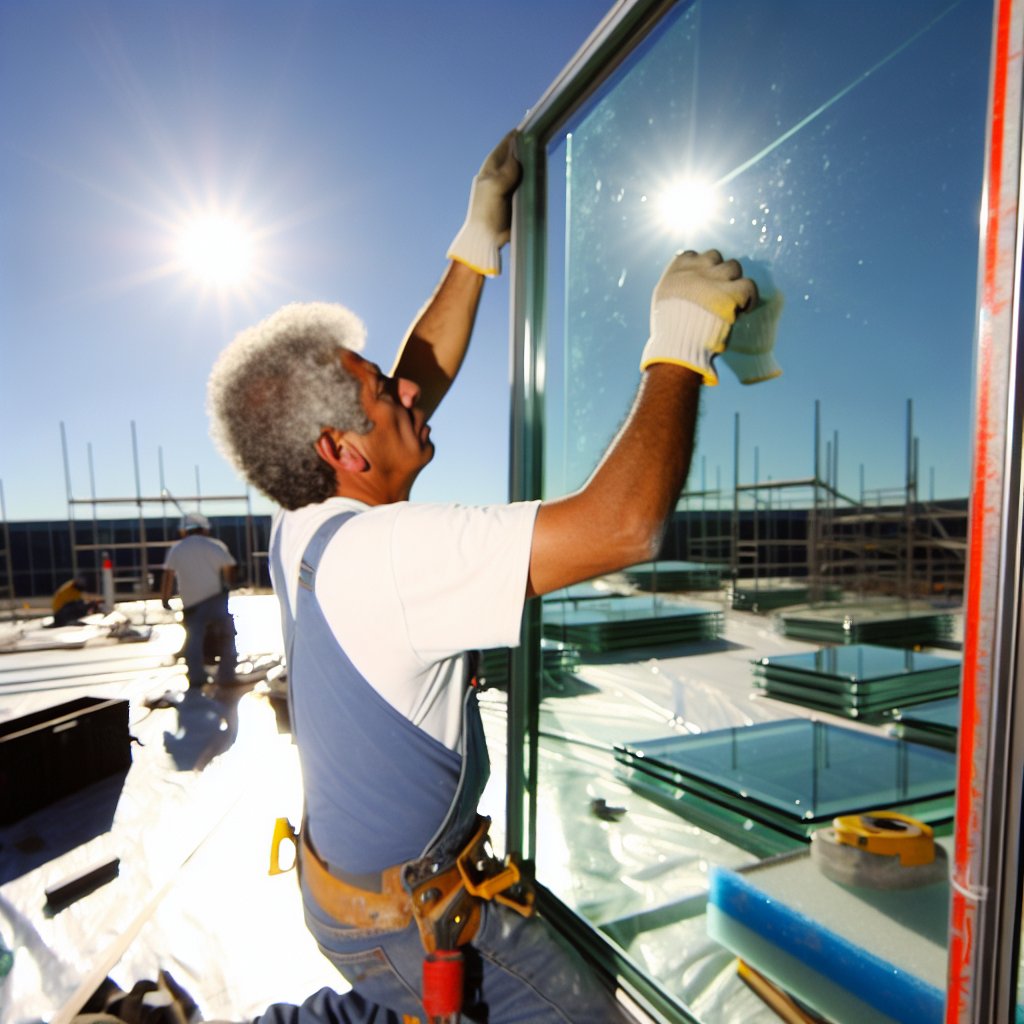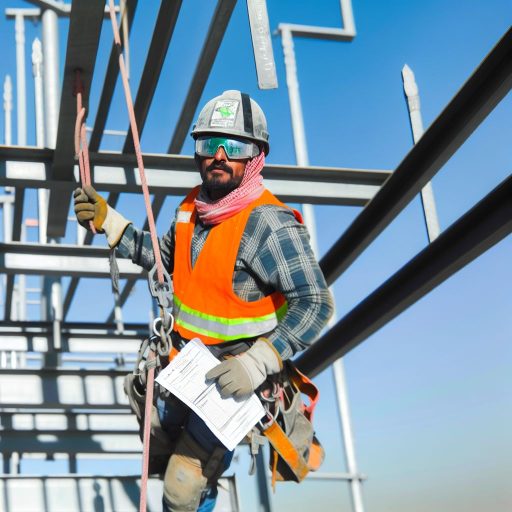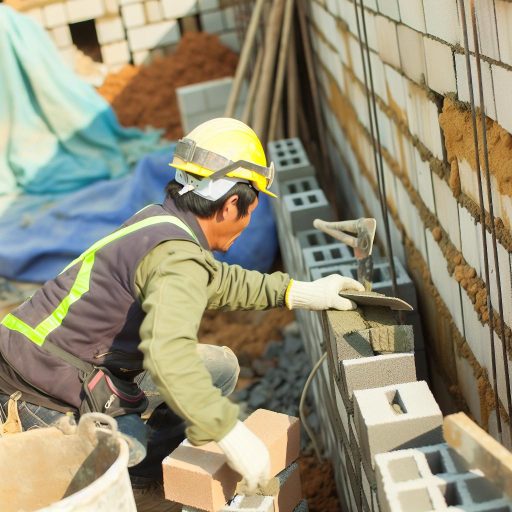Glaziers play a crucial role in constructing buildings by installing glass panels and windows.
Energy-efficient buildings are essential today to reduce carbon emissions and save on energy costs.
Benefits of Energy-Efficient Glazing
Glaziers help in selecting and installing energy-efficient glass that improves insulation and reduces heat loss.
These specialized glazing techniques can significantly decrease the energy consumption of a building.
Utilizing Low-E Glass
Glaziers often use Low-E glass, which has a special coating that reflects heat back into the building.
This minimizes the need for heating or cooling, resulting in lower energy bills for occupants.
Proper Installation Techniques
Glaziers ensure a proper seal around windows to prevent air leakage and maintain the building’s thermal efficiency.
This meticulous installation process enhances the overall energy performance of the structure.
Incorporating Sustainable Design
Glaziers work with architects to incorporate sustainable design elements in the building’s glass facade.
These innovations not only enhance energy efficiency but also contribute to a more eco-friendly environment.
Importance of Glaziers in Modern Construction
Glaziers are integral to creating energy-efficient buildings by utilizing advanced glass technologies and installation techniques.
Their expertise not only enhances the building’s aesthetics but also plays a vital role in conserving energy and reducing environmental impact.
Definition of a Glazier
A glazier is a skilled tradesperson who specializes in cutting, installing, and repairing glass in buildings.
Overview of the Tasks and Responsibilities of a Glazier
- Cutting glass to fit specific measurements.
- Installing glass in windows, doors, and skylights.
- Repairing or replacing broken glass.
- Working with a variety of glass types, including tempered and laminated glass.
- Following safety protocols to prevent accidents.
- Collaborating with other construction professionals, such as architects and contractors.
Importance of Glaziers in the Construction Industry
Glaziers play a crucial role in creating energy-efficient buildings.
They help maximize natural light, reducing the need for artificial lighting.
Properly installed windows and skylights contribute to energy conservation.
Glaziers can install energy-efficient glass with low emissivity coatings.
They ensure proper insulation to prevent heat loss or gain.
Overall, glaziers contribute to sustainable and environmentally friendly construction practices.
Types of Energy-Efficient Glass Used by Glaziers
Transform Your Career Today
Unlock a personalized career strategy that drives real results. Get tailored advice and a roadmap designed just for you.
Start NowExplanation of Different Types of Energy-Efficient Glass
When it comes to energy-efficient glass, there are several types that glaziers commonly use in buildings.
Some of the most popular ones include:
- Low-E (Low Emissivity) Glass: This type of glass has a special coating that helps to reflect heat back into the room during winter and prevent heat from entering in summer.
- Double Glazed Windows: These windows have two panes of glass with a gap in between that is filled with argon gas. This provides excellent insulation and reduces heat loss.
- Triple Glazed Windows: Similar to double glazed windows, but with an additional pane of glass for even better insulation and energy efficiency.
- Tinted Glass: Tinted glass helps to reduce the amount of heat that enters a building, keeping it cooler and reducing the need for air conditioning.
- Smart Glass: This type of glass can change its transparency in response to external conditions, allowing for better control of light and heat entering the building.
Benefits of Using Energy-Efficient Glass in Buildings
Using energy-efficient glass in buildings offers a wide range of benefits, including:
- Reduced Energy Consumption: Energy-efficient glass helps to keep buildings cooler in summer and warmer in winter, reducing the need for heating and cooling systems.
- Lower Utility Bills: With less reliance on heating and cooling systems, buildings with energy-efficient glass typically have lower energy bills.
- Improved Comfort: Energy-efficient glass helps to maintain a more consistent indoor temperature, creating a more comfortable living or working environment.
- Increased Sustainability: By reducing energy consumption, buildings with energy-efficient glass contribute to lower carbon emissions and a more sustainable future.
Impact of Energy-Efficient Glass on Energy Consumption of Buildings
The use of energy-efficient glass in buildings can have a significant impact on energy consumption.
By providing better insulation and heat control, energy-efficient glass helps to reduce the amount of energy needed for heating and cooling.
This not only lowers energy bills for building owners but also contributes to overall energy savings and environmental sustainability.
Discover More: The Future of Construction Management
Installation Techniques for Energy-Efficient Glass
Installing energy-efficient glass requires a specific set of techniques to ensure proper functionality.
Here is an overview of the process:
- Clean the area: Before installing the glass, it is essential to clean the area where it will be placed to ensure a proper seal and adhesion.
- Measurements: Accurate measurements are crucial to ensure the glass fits perfectly and minimizes gaps that could cause energy loss.
- Sealants: Using high-quality sealants and adhesives is essential to create an airtight seal around the glass panels.
- Proper support: Energy-efficient glass panels are often heavier than traditional glass, so proper support must be provided during installation.
- Insulation: To maximize energy efficiency, proper insulation around the glass panels is crucial to prevent heat loss or gain.
Importance of Proper Installation Techniques
Correct installation techniques are essential for maximizing the energy efficiency of buildings.
Poorly installed glass panels can lead to air leakage, heat transfer, and decreased insulation, resulting in higher energy consumption.
By following the correct installation techniques, such as ensuring a proper seal, accurate measurements, and adequate support, glaziers can help minimize energy loss.
This approach creates a more comfortable and sustainable environment for building occupants.
Role of Glaziers in Ensuring Correct Installation
Glaziers play a critical role in ensuring energy-efficient glass is installed correctly.
Their expertise and knowledge in handling and installing glass panels make them vital to the energy efficiency of buildings.
Glaziers are trained to follow specific installation techniques that are essential for the proper functioning of energy-efficient glass.
They work closely with architects, contractors, and building owners to ensure that the glass is installed according to industry standards and specifications.
Their attention to detail, precision, and commitment to quality craftsmanship are essential for creating energy-efficient buildings.
By understanding the importance of proper installation techniques and the role of glaziers, building owners can improve energy efficiency.
Showcase Your Business Today
Reach thousands of readers actively exploring professional services. Publish your business profile and grow your audience now.
Publish NowThis contributes to a more sustainable future.
See Related Content: How to Paint Outdoor Furniture for Durability
Contribution to reducing heat loss and gain
- Explanation of how energy-efficient glass helps in reducing heat loss and gain
- Importance of controlling heat transfer for energy efficiency
- Examples of how glaziers contribute to minimizing heat loss
Explanation of how energy-efficient glass helps in reducing heat loss and gain
Energy-efficient glass, such as low-emissivity (low-e) glass, is designed to reduce heat transfer through windows.
It has a special coating that reflects heat back into the room during winter months.
This helps to maintain a comfortable indoor temperature.
In the summer, this same coating blocks out the heat from the sun.
This prevents excess heat from entering the building.
This helps to reduce the reliance on heating and cooling systems.
Ultimately, this lowers energy consumption and costs.
Importance of controlling heat transfer for energy efficiency
Controlling heat transfer is crucial for achieving energy efficiency in buildings.
Heat loss through windows can account for a significant portion of a building’s energy consumption.
This is especially true in colder climates.
By using energy-efficient glass, glaziers can help to minimize heat loss during the winter.
They can also prevent heat gain during the summer.
This not only improves the comfort of occupants but also reduces the carbon footprint of the building.
Examples of how glaziers contribute to minimizing heat loss
- Installing double or triple-pane windows with low-e coatings:
Glaziers can enhance the energy efficiency of windows by installing multiple panes of glass with insulating gas in between. - Applying weather-stripping and caulking:
Glaziers can seal gaps and cracks around windows to prevent air leakage. - Using thermal breaks in window frames:
Glaziers can incorporate thermal breaks in window frames to reduce heat transfer through the frame itself.
Gain More Insights: How to Estimate Costs for Roofing Projects
Importance of Sealing and Insulation in Energy-Efficient Buildings
Sealing and insulation play a vital role in reducing energy consumption.
They maintain a comfortable indoor environment.
Role of Glaziers in Ensuring Proper Sealing and Insulation of Windows
Glaziers are responsible for installing and sealing windows correctly.
This prevents air leaks and heat loss.
They use high-quality materials and techniques to ensure a tight seal.
Proper insulation around window frames is also crucial.
Impact of Sealing and Insulation on Energy Consumption
Effective sealing and insulation help minimize energy loss.
This leads to lower heating and cooling costs.
By reducing air infiltration and heat transfer, buildings maintain stable indoor temperatures.
This minimizes the overworking of HVAC systems.
Improved insulation reduces reliance on artificial heating and cooling.
This makes the building more energy-efficient.
- Proper sealing and insulation reduce drafts and cold spots.
- They also contribute to a quieter indoor environment.
- Energy-efficient buildings have a smaller carbon footprint.
The work of glaziers in ensuring proper sealing and insulation of windows is crucial.
They are essential for creating energy-efficient buildings.
Uncover the Details: Understanding Construction Project Lifecycles

Collaborations with Architects and Designers
Collaboration between glaziers, architects, and designers is essential for creating energy-efficient buildings.
Each party brings a unique set of skills and expertise to the table.
This approach allows for a holistic approach to design and construction.
Glaziers specialize in installing glass products, which play a crucial role in the overall energy performance of a building.
Architects focus on the overall design and functionality of a structure.
Designers bring aesthetic elements to the project.
By working together, these professionals can ensure that the building is not only visually appealing but also energy-efficient.
Ways in Which Glaziers Contribute to the Design of Energy-Efficient Buildings
Glaziers contribute to the design of energy-efficient buildings in several ways.
One of the key contributions is the selection and installation of high-performance windows and glass facades.
Showcase Your Business Today
Reach thousands of readers actively exploring professional services. Publish your business profile and grow your audience now.
Publish NowThese products help regulate the amount of natural light and heat entering the building.
This regulation reduces the need for artificial lighting and heating.
Glaziers also work closely with architects and designers to design custom glass solutions.
These solutions enhance the building’s energy efficiency.
By incorporating innovative glazing techniques and technologies, glaziers can maximize the building’s thermal performance.
This helps to reduce energy consumption.
Examples of Successful Collaborations in Creating Energy-Efficient Structures
There are numerous examples of successful collaborations between glaziers, architects, and designers in creating energy-efficient structures.
For instance, the Bullitt Center in Seattle is a prime example.
This building incorporates innovative glazing solutions to achieve high energy performance.
Designed by architect Miller Hull and built by glazing contractor Walters & Wolf, the Bullitt Center features advanced daylighting systems.
Energy-efficient glass facades help minimize energy usage.
The collaboration between these professionals resulted in a sustainable building.
It is both visually stunning and environmentally friendly.
Another example is the Edge in Amsterdam.
This smart building utilizes cutting-edge glazing technology to reduce energy consumption.
Designed by PLP Architecture and built with glazing expertise from Seele, the Edge features dynamic glass facades.
These facades adjust to external conditions, optimizing natural light and heat gain.
This collaboration demonstrates how innovative glass solutions can contribute to energy efficiency.
Collaborations between glaziers, architects, and designers play a crucial role in creating energy-efficient buildings.
By leveraging their respective skills and expertise, these professionals can design and construct structures that are sustainable.
They can ensure buildings are visually appealing and environmentally friendly.
The examples of successful collaborations highlighted in this text illustrate the positive impact of teamwork.
This teamwork achieves energy efficiency in the built environment.
Maintenance and repair of energy-efficient glass
Regular maintenance is crucial for ensuring the energy efficiency of buildings with glass components.
Glaziers play a key role in repairing any damaged energy-efficient glass to maintain the overall efficiency of the building.
Importance of regular maintenance for ensuring energy efficiency
- Regular maintenance helps in identifying any potential issues with energy-efficient glass early on.
- Addressing these issues promptly can prevent further damage and maintain the efficiency of the glass.
- Regular checks also ensure that the glass is performing optimally, reducing energy costs in the long run.
Role of glaziers in repairing damaged energy-efficient glass
- Glaziers are specialized professionals trained to work with various types of glass, including energy-efficient glass.
- They can assess the extent of damage to the glass and recommend the best course of action for repair.
- Glaziers have the necessary tools and expertise to repair damaged energy-efficient glass efficiently and effectively.
Tips for maintaining energy-efficient glass in buildings
- Regularly clean the glass surfaces to prevent dirt buildup, which can reduce its efficiency.
- Check for any signs of damage, such as cracks or chips, and address them promptly.
- Ensure that the glass seals are intact to prevent any air leakage that can affect energy efficiency.
- Consider applying a protective coating to the glass to enhance its durability and efficiency.
- Consult with a professional glazier for regular maintenance and inspections of energy-efficient glass.
By following these tips and relying on the expertise of glaziers, building owners can ensure that their energy-efficient glass remains in top condition, contributing to overall energy efficiency and cost savings.
Enhancing Energy Efficiency through Glazing
Glaziers play a critical role in enhancing energy efficiency in buildings by installing advanced glass technologies.
Investing in energy-efficient glass is essential for sustainable construction practices and reducing overall energy consumption.
By choosing the right glaziers and materials, we can create environmentally friendly structures that promote a greener future.
Additional Resources
Re-Assessing Green Building Performance: A Post Occupancy …
Energy Efficiency in Sustainable Buildings: A Systematic Review …
[E-Books for Sale]
The Big Book of 500 High-Paying Jobs in America: Unlock Your Earning Potential
$19.99 • 500 High-Paying Jobs • 330 pages
Explore 500 high-paying jobs in America and learn how to boost your career, earn more, and achieve success!
See All 500 High-Paying Jobs of this E-Book
1001 Professions Without a Degree: High-Paying American Jobs You Can Start Now
$19.99 • 1001 Professions Without a Degree • 174 pages
Discover 1001 high-paying jobs without a degree! Unlock career tips, skills, and success strategies for just $19.99!




